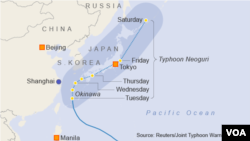A weakened Typhoon Neoguri has killed at least one person as it continues to batter Japan's southern islands of Okinawa, knocking out power and canceling hundreds of flights.
Although the storm was downgraded from a super typhoon, more than 500,000 residents of the island chain were encouraged to evacuate as heavy rains and sustained winds of up to 180 kph forced many into shelters on Tuesday.
Despite warnings from Japan's weather agency that waves could reach as high as 14 meters (45 feet) a 62-year-old fisherman died after being knocked out of his boat.
Okinawa police said at least four people were injured.
More than 500,000 people were urged to evacuate or take shelter, and hundreds of flights were canceled as Neoguri brought torrential rain and high winds to Japan's south-western islands.
Typhoon Neoguri was downgraded early Tuesday from a super typhoon, but the Japan Meteorological Agency said the storm is still packing wind gusts of up to 250 kilometers per hour.
Neoguri was roughly 110 kilometers (68 miles) south-west of Kumejima island at noon (0300 GMT) and moving north at 25 kph (16 mph), with sustained winds of 180 kph (110 mph).
Kadena Air Base, one of the largest U.S. military facilities in Asia, was at its highest level of storm alert and all outside activity was prohibited. Some aircraft at the base were evacuated as the storm approached.
A Japan Meteorological Agency official said the storm will maintain its strength as it heads north but gradually turn to the east, making landfall in Kyushu before raking its way up the main island of Honshu and coming close to Tokyo and Osaka on Friday as a tropical storm.
Little damage so far
Chief Cabinet Secretary Yoshihide Suga said there are no reports of major damage so far, although nearly 70,000 Okinawan households had no power, public broadcaster NHK said.
"We have not received any information concerning great damage or injury. The prime minister [Shinzo Abe] has ordered the government to provide information to our citizens and to prepare thoroughly for any disaster and to respond quickly if anything is to happen," said Suga.
Television footage showed a building shattered, damaged storefronts and trees toppled as winds picked up in the Okinawan capital of Naha.
After passing over Okinawa, forecasters expect Neoguri to hit Kyushu island, which hosts two nuclear facilities, both of which have been shut down ahead of the storm's arrival.
In China, tourists evacuated coastal parts of Zhejiang Province on Tuesday morning before the arrival of Typhoon Neoguri.
The storm is expected to pass across the sea waters off the province on Tuesday afternoon and night.
Tourists holidaying on islands near the coast of Zhejiang were asked to leave for safe locations.
A total of 90 tourists on Dalu Island in Taizhou, a coastal city in Zhejiang, were evacuated early Tuesday and no tourists will be permitted to enter the island again before the typhoon passes.
Landslides, flooding
Typhoon Neoguri is forecast to lose more of its power over land, but much of the damage from such storms comes from downpours that cause landslides and flooding. Such risks are elevated by the storm's timing, coming on the tail end of Japan's summer rainy season.
Japan usually is hit by several typhoons each year, but it is unusual for such a storm to hit as early as July.
Neoguri comes less than a year after Typhoon Haiyan, packing the strongest winds ever recorded on land, killed or left missing more than 7,300 people as it tore across the central Philippines in November.
Some information for this report provided by Reuters, AFP and AP.








